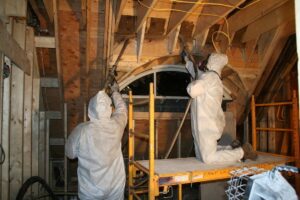Mold Removal Process Cooksville
Long-term mold exposure can have serious health consequences. Even more, the presence of mold can negatively affect buyers and sellers during real estate transactions. A mold is a form of fungus that may be found practically anywhere there is moisture and oxygen. Mold grows rapidly in damp places and thrives in the correct circumstances. Mold is detrimental to us, and each person will experience its effects differently allergies, nausea, headaches, respiratory ailments, itching, and more are typical mold symptoms. If you suspect mold in your house or property in cooksville, you should take quick action since mold spores can multiply very quickly
In places where moisture has been present for a long period, mold can develop. Leaks, standing water in the crawl area, a previously flooded basement, and incorrect exhaust fan venting are a few examples. Mold can get into a person’s respiratory system, come into contact with their skin, or even get into their stomach. It is challenging to foresee the kind and extent of the health impacts of mold exposure. Although mold frequently causes allergy-like symptoms, it can also occasionally result in serious health issues. Cough, wheeze, sore throat, nasal/sinus congestion, skin/eye irritation, and upper respiratory infections are a few signs of mold exposure

Mold Removal in Cooksville
One of the top companies for mold repair and removal is mold Cooksville. Cooksville’s former clients can vouch for the fact that we are capable of removing mold from any location, including hard-to-reach cracks in ceilings and inside walls. We take our responsibility to offer you, your family, or your business the best mold removal and mold remediation solutions very seriously. Moist air or pooled water in one place can cause mold to grow. Rapid mold remediation is essential to prevent it from spreading and destroying further surfaces. Using our cutting-edge machinery,
The following are the most typical health problems, although the sort of reaction to mold depends on the type of mold that is present:
- Breathing problems
- Immune reactions
- Headaches
- Chronic cough and cold symptoms
- Burning in the eyes, nose, throat, and lungs from skin irritation
- Hypersensitivity pneumonitis
Mold removal and mold treatment are the two steps of the mold damage repair process. We take all required precautions to guarantee the safety and lack of mold in your building in cooksville.
Mold cooksville services include:
- Mold testing
- Mold inspection
- Mold removal
- Mold remediation
Mold testing in Cooksville
When our technicians come on-site, they conduct a mold test and inspection as their first action. Our goal is to identify the mold kind so that it can be efficiently treated in cooksville. We perform an airborne mold test. Your property need not be evacuated if the air quality is good. Following that, we attempt to visually find and categorize the mold utilizing specialized testing tools and cameras that can reveal what is hidden inside difficult-to-reach spaces like ceilings and wall cracks. A report summarizing the findings assigns grades to the type and degree of mold spread.
Black Mold Elimination
There are different variations of mold all around us. Some are toxic and some are not. Black mold is the most dangerous variety of mold. Large black stains on walls or other surfaces are typical black mold symptoms. Black mold emits a pretty potent odor as well. The quantity of moisture in the air in the room where black mold is present is typically correlated with how much it develops. If black mold is not identified and treated very away, serious health issues may result. Breathing difficulties and bronchial asthma can be brought on by black mold in cooksville.
Mold testing: how is mold testing carried out in cooksville?
We are dedicated to giving our customers the finest experience possible. Our objective is to put you back on the path to a mold-free, cleaner environment. These easy actions are the first in that procedure. An examination and survey of a property to gather data on the existence, recognition, or assessment of mold results are documented in an assessment report that lists all observations, measurements, sample locations, and analytical findings. A mold management plan will also be provided, providing instructions to the client on how to stop and manage indoor growth at a place
Typically, a sample of the air or a surface is taken to test for mold. A mold inspector essentially “tests” the air or surface to determine what type of mold is present and/or if the mold can grow in the area examined.
Air Samples
There are numerous methods for collecting and analyzing air samples. The approach that is used the most frequently is referred to as a “spore trap sample” for spore traps to function, a known volume of air must pass through the sample device, impact a sticky surface, and then exit. The majority of airborne particles interact with this sticky surface as well, adhering to and being trapped on it as a result. A subset of these “particles in the air” are mold spores, which are also caught by the sticky material inside the spore trap. The mold testing laboratory opens the spore trap after receiving it for analysis, uses some stains to cover the sticky surface that the mold spores can absorb, and then classifies and measures the different kinds of mold spores that were collected throughout the sampling procedure. Other mold sampling techniques exist, such as cultivating or growing mold spores that have been collected from the air, but they are less frequently utilized in Cooksville.
Testing For Mold: Surface Samples
There are numerous methods for collecting surface samples for mold removal in Cooksville. The three most typical techniques are:
Large samples. Swab samples are used to physically remove a portion of the sampled area and send it to the mold testing lab. The area being sampled, which is frequently a measured area, is touched with something resembling a cotton swab before being delivered to the mold testing facility, and
Samples of tape.
Supposedly collecting up and removing some of the mold that was on the surface, a piece of transparent tape is applied to and removed from the area being tested before being delivered to the mold testing facility for analysis.
